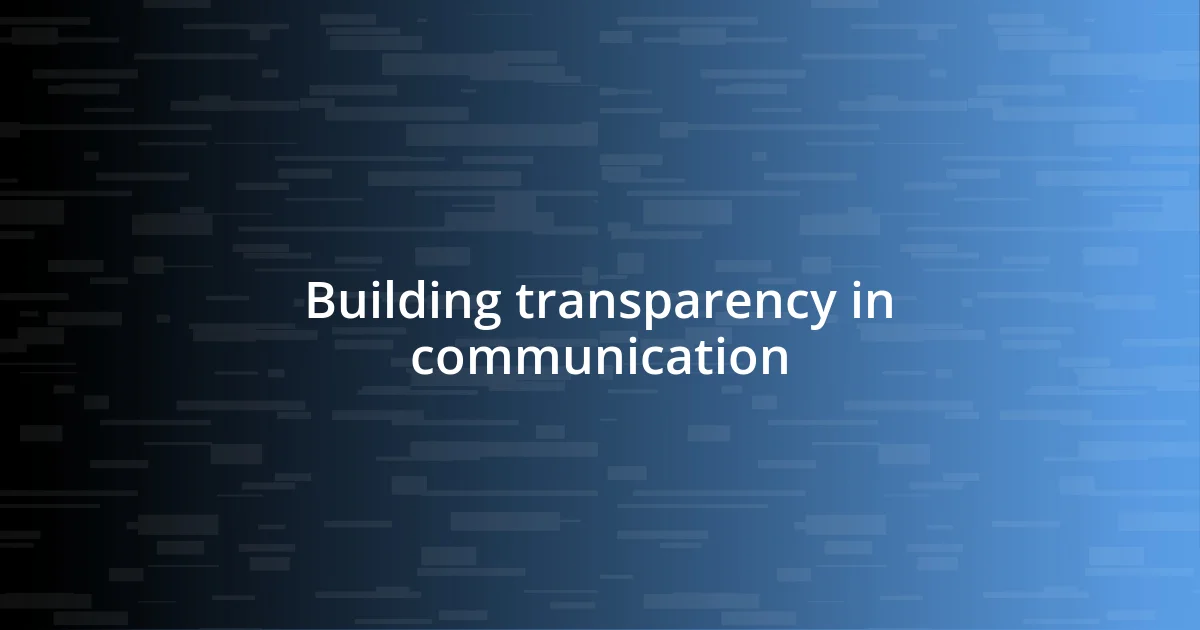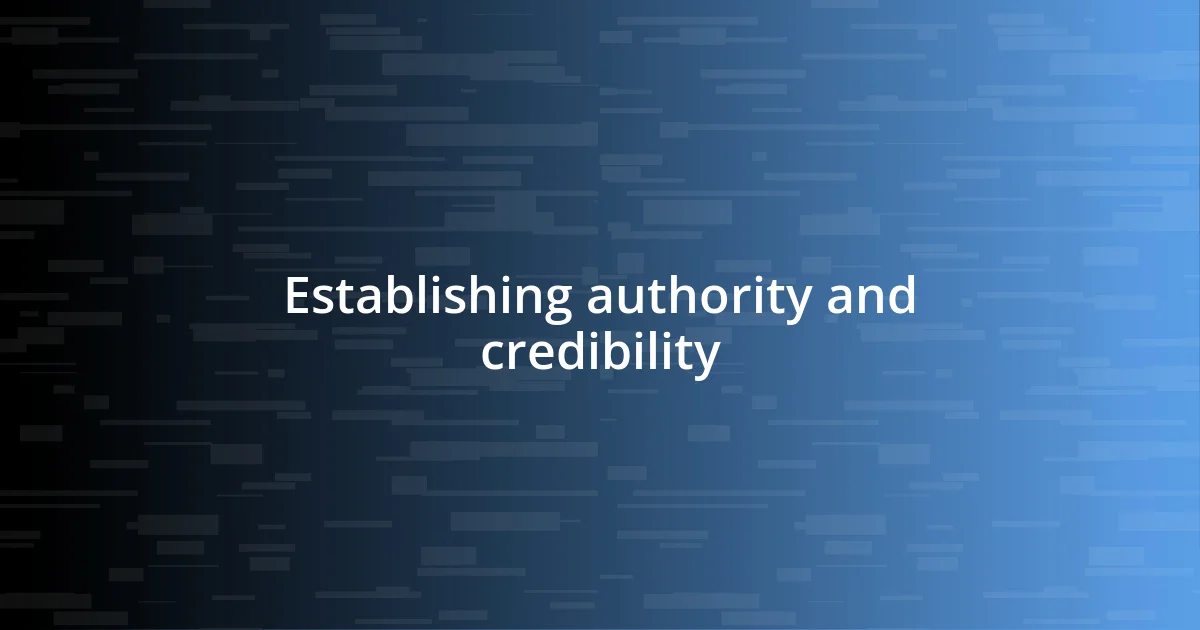Key takeaways:
- Building trust with an audience involves authenticity, vulnerability, and open communication to create a safe space for engagement.
- Consistent content that reflects audience interests fosters a sense of belonging and keeps the audience engaged and valued.
- Personalization and acknowledgment of individual experiences strengthen relationships, encouraging deeper connections and loyalty among audience members.

Understanding the importance of trust
Trust is the bedrock of any meaningful relationship, including the one I cultivate with my audience. Without it, my message can easily get lost in the noise, and that’s not a place I want to be. Remember that moment when you shared a personal story with someone and felt a connection? Trust is that invisible thread that ties us together, allowing for authentic conversations to flourish.
When I think about trust, I often recall a time when a reader reached out to me after a particularly vulnerable post. They shared their own struggles, which made me realize how deeply trust can resonate. It’s not just about delivering information; it’s about creating a safe space where people feel seen and understood. How can we expect our audience to respond openly if we don’t show them that we genuinely care about their experiences?
In today’s world, where skepticism runs high, the importance of trust becomes even more pronounced. I find myself constantly evaluating how I communicate. Do I listen as much as I speak? I believe that building trust is a two-way street; it requires authenticity, transparency, and yes, a little vulnerability. If I can share my ups and downs, I invite my audience to do the same, forging a relationship that is both supportive and enduring.

Identifying your audience needs
Identifying the needs of my audience is a crucial step in building that trust. I remember the first time I conducted a survey to truly understand what my readers were seeking. It was enlightening! I discovered interests and concerns I hadn’t even considered. This experience taught me that engaging directly with my audience helps me tailor my content to meet their expectations.
Listening goes beyond just gathering information. After hosting a Q&A session, I received feedback that surprised me. Many readers craved practical tips rather than general advice. This insight has been invaluable. It emphasizes the importance of actively seeking out and analyzing your audience’s needs to foster a deeper connection.
Understanding who my audience is not just a one-time task. It’s an ongoing journey. I continually monitor feedback, comments, and social media interactions for clues about their evolving preferences. This constant vigilance helps me stay relevant and reinforces that I truly care about their experiences. Open dialogue is key—it reminds me that every question and comment enriches my understanding of their needs.
| Technique | Description |
|---|---|
| Surveys | Gather direct feedback from readers to understand their interests and needs. |
| Q&A Sessions | Engage directly with your audience to uncover their specific desires or concerns. |
| Monitoring Interactions | Analyze comments and social media engagement to adapt content to audience preferences. |

Building transparency in communication
Building transparency in communication starts with being honest and straightforward in my interactions. I remember a time when I shared a mistake I made in a previous post. Instead of hiding it, I laid it out for my audience and explained what I learned from it. The response was overwhelmingly positive, showing me that my vulnerability created a stronger bond. It was a lesson in how authenticity can foster trust.
Here are some strategies that have helped me build transparency:
- Admit Mistakes: Acknowledging my errors fosters credibility. When I share lessons learned, it resonates with my audience.
- Be Open About Processes: I often explain my content creation process. This openness invites my audience to see how much effort goes into providing valuable information.
- Encourage Questions: I actively invite feedback and queries, making it clear that I’m here to engage and learn together with my audience.
In my journey toward building transparent communication, I’ve found that these approaches not only strengthen trust, but also create a richer dialogue with those I aim to serve.

Engaging through consistent content
Engaging through consistent content is one of the most effective ways I’ve found to bolster trust with my audience. Regularly uploading blog posts that reflect their interests has proven invaluable. I recall a month when I committed to sharing tips on effective time management every Tuesday. The feedback was phenomenal! Readers began to anticipate my posts, sharing how they eagerly used those tips to enhance their productivity.
However, consistency isn’t just about frequency—it’s about relevance. I remember when I shifted my content focus after receiving a number of requests for deeper dives into specific topics. I decided to create a series exploring goal-setting techniques over several weeks. This approach not only kept my audience engaged but also established me as a reliable source on a subject they genuinely cared about. It’s like setting an appointment with a friend; they look forward to that time together.
Ultimately, I’ve discovered that showing up consistently allows my audience to feel a sense of belonging. They keep coming back because I’m not only sharing valuable content but also cultivating a space where their preferences and voices are acknowledged. Have you ever felt that joy of contributing to a community? It’s this sense of connection that keeps the trust alive and thriving!

Encouraging audience feedback and interaction
I truly believe that audience feedback is like a treasure trove, waiting to be discovered. Once, after sharing a particularly vulnerable post, I received a flurry of comments from readers who related to my experience. It made me realize how impactful it can be to encourage dialogue. By actively soliciting thoughts and feelings, I not only validate my audience’s experiences but also deepen the connection we share.
In my journey, I’ve seen the power of interactive content. I often run polls or Q&A sessions on social media to open the floor for discussion. I remember when I asked my audience about their biggest challenges in productivity. The flood of responses not only sparked insightful conversations but also generated content ideas that truly resonated with their needs. Have you ever felt like your voice was heard in a crowded room? That’s the feeling I strive to create.
Encouraging feedback isn’t just about collecting responses; it’s also about showing appreciation for them. I make it a point to respond personally to comments and messages. One time, a reader shared how my advice helped them tackle a tough project at work. Their triumphant message made my day! It reinforces the idea that our conversations matter, fostering an environment where my audience feels valued and engaged. Isn’t it incredible how a simple acknowledgment can strengthen trust?

Establishing authority and credibility
Establishing authority and credibility in my field has been a rewarding journey. When I first started sharing my knowledge, I knew I had to back up my claims with expertise. For instance, I often include personal stories when discussing complex topics, like when I completed a challenging certification. Sharing this experience not only revealed my commitment to learning but also positioned me as a trustworthy guide, showing my audience that I don’t just talk the talk; I walk the walk.
Moreover, I find that sharing well-researched data lends an air of professionalism to my content. I recall a time when I delved into the specifics of productivity statistics during a webinar. By referencing reputable sources, I could confidently answer questions and address concerns. It felt amazing to witness my audience engage with the information, knowing they viewed me as a credible source. Have you ever felt the weight of responsibility when sharing facts? I certainly do, and it drives me to ensure that I’m always delivering accurate content.
Lastly, I emphasize transparency as a keystone of authority. There was an instance when I miscommunicated a detail about a popular productivity tool. Instead of ignoring it, I published a follow-up post confessing the mistake and clarifying the information. This candid approach not only enhanced my credibility but also reinforced a sense of mutual respect with my audience. After all, who doesn’t appreciate honesty in a world full of perfect facades? It’s those moments of vulnerability that often make trust flourish.

Nurturing relationships through personalization
Nurturing relationships through personalization is all about recognizing and celebrating the individuality of my audience. Recently, I started personalizing my emails by using subscribers’ first names and tailoring content based on their previous engagement. It may seem like a small touch, but when I see someone respond positively to an email that feels like it was crafted just for them, I can’t help but smile. Don’t you think we all crave that personal connection in a digital world?
Another approach I’ve taken is sharing a bit about my journey in relation to my audience’s interests. For example, when I transitioned to remote work, I opened up about the struggles I faced and how I navigated those challenges. That transparency helped create intimacy in our relationship, as many readers shared similar experiences. Have you ever opened up and discovered a shared struggle? It truly fosters a bond like no other.
I also make it a point to remember special moments, like milestones or achievements that my audience shares with me. There’s something incredibly rewarding about sending a quick note of encouragement when a reader mentions they landed a new job or completed a personal goal. That small gesture reinforces my support for them, strengthening our connection. Isn’t it rewarding to feel seen and appreciated? Those little moments of personalization can have a ripple effect in nurturing trust and loyalty.














